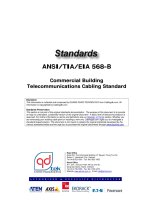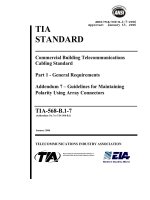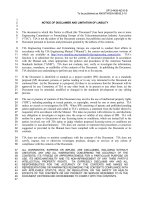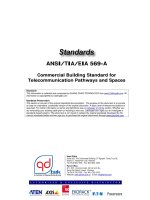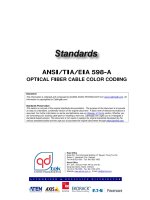Cabling Standard - TIA 568 B.1 - Addendum 7 - Final
Bạn đang xem bản rút gọn của tài liệu. Xem và tải ngay bản đầy đủ của tài liệu tại đây (392.66 KB, 28 trang )
TIA
STANDARD
ANSI/TIA-568-B.1-7-2006
Approved: January 13, 2006
Commercial Building Telecommunications
Cabling Standard
Part 1 - General Requirements
Addendum 7 – Guidelines for Maintaining
Polarity Using Array Connectors
TIA-568-B.1-7
(Addendum No.7 to TIA-568-B.1)
January 2006
TELECOMMUNICATIONS INDUSTRY ASSOCIATION
Representing the telecommunications industry in
association with the Electronic Industries Alliance
NOTICE
TIA Engineering Standards and Publications are designed to serve the public interest through
eliminating misunderstandings between manufacturers and purchasers, facilitating
interchangeability and improvement of products, and assisting the purchaser in selecting and
obtaining with minimum delay the proper product for their particular need. The existence of
such Standards and Publications shall not in any respect preclude any member or non-member of
TIA from manufacturing or selling products not conforming to such Standards and Publications.
Neither shall the existence of such Standards and Publications preclude their voluntary use by
Non-TIA members, either domestically or internationally.
Standards and Publications are adopted by TIA in accordance with the American National
Standards Institute (ANSI) patent policy. By such action, TIA does not assume any liability to
any patent owner, nor does it assume any obligation whatever to parties adopting the Standard or
Publication.
This Standard does not purport to address all safety problems associated with its use or all
applicable regulatory requirements. It is the responsibility of the user of this Standard to
establish appropriate safety and health practices and to determine the applicability of regulatory
limitations before its use.
(From Standards Proposal No. 3-4425-AD7-C formulated under the cognizance of the TIA
TR-42.8 Subcommittee on Telecommunications Optical Fiber Cabling Systems).
Published by
©TELECOMMUNICATIONS INDUSTRY ASSOCIATION
Standards and Technology Department
2500 Wilson Boulevard
Arlington, VA 22201 U.S.A.
PRICE: Please refer to current Catalog of
TIA TELECOMMUNICATIONS INDUSTRY ASSOCIATION STANDARDS
AND ENGINEERING PUBLICATIONS
or call Global Engineering Documents, USA and Canada
(1-800-854-7179) International (303-397-7956)
or search online at
All rights reserved
Printed in U.S.A.
NOTICE OF COPYRIGHT
This document is copyrighted by the TIA.
Reproduction of these documents either in hard copy or soft copy (including
posting on the web) is prohibited without copyright permission. For copyright
permission to reproduce portions of this document, please contact TIA Standards
Department or go to the TIA website (www.tiaonline.org) for details on how to request
permission. Details are located at:
OR
Telecommunications Industry Association
Standards & Technology Department
2500 Wilson Boulevard, Suite 300
Arlington, VA 22201 USA
+1(703)907-7700
Organizations may obtain permission to reproduce a limited number of copies by
entering into a license agreement. For information, contact:
Global Engineering Documents
15 Inverness Way East
Englewood, CO 80112-5704 or call
U.S.A. and Canada (1-800-854-7179)
International (303) 397-7956
NOTICE OF DISCLAIMER AND LIMITATION OF LIABILITY
The document to which this Notice is affixed (the “Document”) has been prepared by one or more Engineering
Committees or Formulating Groups of the Telecommunications Industry Association (“TIA”). TIA is not the author of the
Document contents, but publishes and claims copyright to the Document pursuant to licenses and permission granted by the
authors of the contents.
TIA Engineering Committees and Formulating Groups are expected to conduct their affairs in accordance with the
TIA Engineering Manual (“Manual”), the current and predecessor versions of which are available at
/>. TIA’s function is to administer the process, but not the
content, of document preparation in accordance with the Manual and, when appropriate, the policies and procedures of the
American National Standards Institute (“ANSI”). TIA does not evaluate, test, verify or investigate the information,
accuracy, soundness, or credibility of the contents of the Document. In publishing the Document, TIA disclaims any
undertaking to perform any duty owed to or for anyone.
If the Document is identified or marked as a project number (PN) document, or as a standards proposal (SP)
document, persons or parties reading or in any way interested in the Document are cautioned that: (a) the Document is a
proposal; (b) there is no assurance that the Document will be approved by any Committee of TIA or any other body in its
present or any other form; (c) the Document may be amended, modified or changed in the standards development or any
editing process.
The use or practice of contents of this Document may involve the use of intellectual property rights (“IPR”),
including pending or issued patents, or copyrights, owned by one or more parties. TIA makes no search or investigation for
IPR. When IPR consisting of patents and published pending patent applications are claimed and called to TIA’s attention, a
statement from the holder thereof is requested, all in accordance with the Manual. TIA takes no position with reference to,
and disclaims any obligation to investigate or inquire into, the scope or validity of any claims of IPR. TIA will neither be a
party to discussions of any licensing terms or conditions, which are instead left to the parties involved, nor will TIA opine
or judge whether proposed licensing terms or conditions are reasonable or non-discriminatory. TIA does not warrant or
represent that procedures or practices suggested or provided in the Manual have been complied with as respects the
Document or its contents.
TIA does not enforce or monitor compliance with the contents of the Document. TIA does not certify, inspect, test or
otherwise investigate products, designs or services or any claims of compliance with the contents of the Document.
ALL WARRANTIES, EXPRESS OR IMPLIED, ARE DISCLAIMED, INCLUDING WITHOUT LIMITATION, ANY
AND ALL WARRANTIES CONCERNING THE ACCURACY OF THE CONTENTS, ITS FITNESS OR
APPROPRIATENESS FOR A PARTICULAR PURPOSE OR USE, ITS MERCHANTABILITY AND ITS NON-
INFRINGEMENT OF ANY THIRD PARTY’S INTELLECTUAL PROPERTY RIGHTS. TIA EXPRESSLY
DISCLAIMS ANY AND ALL RESPONSIBILITIES FOR THE ACCURACY OF THE CONTENTS AND MAKES NO
REPRESENTATIONS OR WARRANTIES REGARDING THE CONTENT’S COMPLIANCE WITH ANY
APPLICABLE STATUTE, RULE OR REGULATION, OR THE SAFETY OR HEALTH EFFECTS OF THE
CONTENTS OR ANY PRODUCT OR SERVICE REFERRED TO IN THE DOCUMENT OR PRODUCED OR
RENDERED TO COMPLY WITH THE CONTENTS.
TIA SHALL NOT BE LIABLE FOR ANY AND ALL DAMAGES, DIRECT OR INDIRECT, ARISING FROM OR
RELATING TO ANY USE OF THE CONTENTS CONTAINED HEREIN, INCLUDING WITHOUT LIMITATION
ANY AND ALL INDIRECT, SPECIAL, INCIDENTAL OR CONSEQUENTIAL DAMAGES (INCLUDING DAMAGES
FOR LOSS OF BUSINESS, LOSS OF PROFITS, LITIGATION, OR THE LIKE), WHETHER BASED UPON BREACH
OF CONTRACT, BREACH OF WARRANTY, TORT (INCLUDING NEGLIGENCE), PRODUCT LIABILITY OR
OTHERWISE, EVEN IF ADVISED OF THE POSSIBILITY OF SUCH DAMAGES. THE FOREGOING NEGATION
OF DAMAGES IS A FUNDAMENTAL ELEMENT OF THE USE OF THE CONTENTS HEREOF, AND THESE
CONTENTS WOULD NOT BE PUBLISHED BY TIA WITHOUT SUCH LIMITATIONS.
TIA-568-B.1-7
ii
Guidelines for Maintaining Polarity Using Array Connectors,
Addendum 7 to ANSI/TIA/EIA/568B.1
Table of Contents
FOREWORD ...................................................................................................................................iv
1
INTRODUCTION ..................................................................................................................... 1
2
SCOPE .................................................................................................................................... 2
3
CONNECTIVITY METHODS FOR ESTABLISHING POLARITY............................................ 2
3.1
General................................................................................................................................ 2
3.1.1
Descriptions................................................................................................................. 2
3.2
Connectivity Method A......................................................................................................... 3
3.2.1
Connectivity Method A for Duplex Signals .................................................................. 3
3.2.2
Connectivity Method A for Parallel Signals.................................................................. 5
3.3
Connectivity Method B......................................................................................................... 7
3.3.1
Connectivity Method B for Duplex Signals .................................................................. 7
3.3.2
Connectivity Method B for Parallel Signals.................................................................. 9
3.4
Connectivity Method C ...................................................................................................... 11
3.4.1
Connectivity Method C for Duplex Signals................................................................ 11
4
GUIDELINES FOR CONNECTIVITY COMPONENTS ......................................................... 13
4.1
General.............................................................................................................................. 13
4.2
Components for Connectivity Method A............................................................................ 14
4.2.1
Type-A Array Connector Cables and Patch Cords.................................................... 14
4.2.2
Type-A Array Adapters .............................................................................................. 14
4.2.3
Transitions ................................................................................................................. 15
4.2.4
A-to-B patch cords..................................................................................................... 16
4.2.5
A-to-A Patch cords..................................................................................................... 16
4.3
Components for Connectivity Method B............................................................................ 17
4.3.1
Type-B Array Connector Cables and Patch Cords.................................................... 17
4.3.2
Type-B Array Adapters .............................................................................................. 17
4.3.3
Transitions ................................................................................................................. 17
4.3.4
A-to-B patch cords..................................................................................................... 17
4.4
Components for Connectivity Method C............................................................................ 18
4.4.1
Type-C Array Connector Cables ............................................................................... 18
4.4.2
Type-A Array Adapters .............................................................................................. 18
4.4.3
Transitions ................................................................................................................. 18
4.4.4
A-to-B patch cords..................................................................................................... 18
ANNEX A (INFORMATIVE) References ....................................................................................... 19
TIA-568-B.1-7
iii
List of Figures
Figure 1: Connectivity Method A for Duplex Signals.........................................................4
Figure 2: Connectivity Method A for Parallel Signals........................................................6
Figure 3: Connectivity Method B for Duplex Signals.........................................................8
Figure 4: Connectivity Method B for Parallel Signals......................................................10
Figure 5: Connectivity Method C for Duplex Signals.......................................................12
Figure 6: Type-A Array Connector Cable or Patch Cord (key-up to key-down)..............14
Figure 7: Transition.........................................................................................................15
Figure 8: A-to-B Duplex Patch Cord................................................................................16
Figure 9: A-to-A Duplex Patch Cord................................................................................16
Figure 10: Type-B Array Connector Cable or Patch Cord (key-up to key-up).................17
Figure 11: Type C Array Connector Cable (pair-wise flipped, key-up to key-down) .......18
List of tables
Table 1: Summary of Components Used for Duplex Signals..........................................13
Table 2: Summary of Components Used for Parallel Signals.........................................13
TIA-568-B.1-7
iv
FOREWORD
(This foreword is not part of this Standard)
After ANSI/TIA/EIA-568-B.1 was approved for publication, it was realized that there was
a need to explain and illustrate the concept of maintaining optical fiber polarity using
array connectors. The TIA TR-42 Engineering Committee on Premises
Telecommunications Cabling Infrastructure accepted the task and assigned it to the TR-
42.8 Subcommittee, Telecommunications Optical Fiber Cabling Systems. The TR-42.8
Subcommittee cooperated with the TR-42.1 Subcommittee on Commercial Building
Cabling, which is related to this activity, in preparing this document.
TIA standards are developed within the Technical Engineering Committees of the TIA
and the standards coordinating committees of the TIA standards board. Members of the
committees serve voluntarily and without commission. The companies that they
represent are not necessarily members of the TIA. The standards developed within the
TIA represent a consensus of the broad expertise on the subject. This expertise comes
from within the TIA as well as those outside of the TIA that have an expressed interest.
The viewpoint expressed at the time that this Telecommunication Systems Bulletin was
approved was from the contributors’ experience and the state of the art at that time.
Users are encouraged to verify that they have the latest revision of the standard.
TIA-568-B.1-7
1
1 INTRODUCTION
To support bi-directional communication systems that use separate optical fibers in each
direction, the cabling system must provide correct signal polarity so that the transmitter on one
end of the channel will connect to the receiver on the other end. Maintaining the correct
transmit-to-receive polarity throughout the cabling system is critical for system operation.
Following certain cable polarity guidelines when installing the cabling system will simplify
channel connectivity.
Correct polarity is administered according to the requirements of the depicted methods.
Intermixing the components of these methods may result in incorrect polarity.
The increasing use of optical connectivity in data communications networks (particularly in
areas of highly concentrated equipment, such as data centers) is driving the need for more
compact forms of connectivity. Array connectors are one way of meeting this need. Since the
polarity requirements for array connectors extend beyond the commonly deployed duplex (A-B)
polarity, additional guidance is provided in this addendum for maintaining polarity of networks
utilizing array connectors.
For illustrative purposes, the figures throughout this document depict the MPO array connector
and 568SC duplex connector. Other connector types are permitted, provided the fiber ordering
arrangement is maintained relative to the plug’s keying features, as shown in the figures.
The figures in this document show connectors labeled with fiber position numbers. This is done
for reference only; it is not a requirement of this standard that connectors be labeled with a fiber
number.
TIA-568-B.1-7
2
2 SCOPE
This Standard provides guidelines for establishing transmit-to-receive polarity using array
connectors. The methods presented in this document provide different options for implementing
polarity. Once a method is selected the details in that method shall be followed.
3 CONNECTIVITY METHODS FOR ESTABLISHING POLARITY
3.1 General
All connectivity methods have the same goal: to create an optical path from the transmit port of
one device to the receive port of another device. Different methods to accomplish this goal may
be implemented; however these different methods may not be interoperable. It is recommended
that a method be selected in advance and maintained consistently throughout an installation.
While many methods are available to establish polarity, this Standard outlines sample methods
that may be employed. For convenience, these sample methods are referred to as Methods A,
B, and C. No preference or priority is implied by this notation.
When mating connectors that use alignment pins (such as the MPO and MT-RJ) it is critical that
one plug is pinned and the other plug is unpinned. The pinned connector is typically located
inside the panel. That is, the connector that stays in place is pinned; the connector that is
frequently removed & handled is unpinned. As MT-RJ or MPO transceivers typically have pins,
this convention leads to the following implementation on initial build out:
• Patch cords from transceiver to panel are typically unpinned on both ends.
• Transitions (mounted behind the panel) are typically pinned.
• Cables from rack to rack are typically unpinned on both ends.
Array connectors can be flat or angle polished. Flat-polished connectors do not optically mate
with angle-polished connectors.
3.1.1 Descriptions
A-to-B patch cord: A duplex patch cord that connects position A on one end of the patch cord
to position B on the other end of the patch cord. See section 4.2.4.
A-to-A patch cord: A duplex patch cord that connects position A on one end of the patch cord
to position A on the other end of the patch cord. See section 4.2.5.
Array Connector: An optical fiber connector containing a single ferrule with multiple terminated
fibers arranged in a line or a series of lines.
Transition: An assembly of optical fibers and connectors, with an array connector on one end
and simplex or duplex connectors on other end.
TIA-568-B.1-7
3
3.2 Connectivity Method A
3.2.1 Connectivity Method A for Duplex Signals
Implementation of Connectivity Method A for duplex signals is shown in Figure 1.
When connecting multiple duplex optical transceiver ports, the Type-A backbone (composed of
one or many Type-A array connector cables mated in Type-A adapters) is connected on each
end to a transition. On one end of the optical link, A-to-B patch cords are used to connect ports
on the transition to their respective duplex transceiver ports. On the other end of the optical link,
A-to-A patch cords are used to connect ports on the transition to their respective duplex
transceiver ports. In each optical path there shall be one and only one A-to-A patch cord.
Guidelines for the construction of the cabling components used to implement Method A are
given in Section 4.2.
TIA-568-B.1-7
4
Figure 1: Connectivity Method A for Duplex Signals
NOTE
1. For ease of illustration the Type-A cable is shown with a twist. This is the same cable construction shown in Figure 6.
Example Optical Path
A-to-B Patch Cord
Type-A Array
Connector Cable
A-to-A Patch Cord


